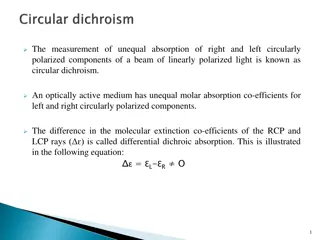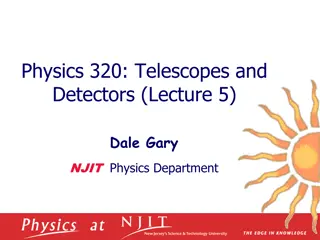Course Code: MSE-S303 Electronic and Optical Materials
Explore the concept of Fermi level and its significance in intrinsic semiconductors. Learn about the behavior of electrons in conduction and valence bands, the Fermi energy, and the impact of temperature on semiconductor properties.
Download Presentation

Please find below an Image/Link to download the presentation.
The content on the website is provided AS IS for your information and personal use only. It may not be sold, licensed, or shared on other websites without obtaining consent from the author.If you encounter any issues during the download, it is possible that the publisher has removed the file from their server.
You are allowed to download the files provided on this website for personal or commercial use, subject to the condition that they are used lawfully. All files are the property of their respective owners.
The content on the website is provided AS IS for your information and personal use only. It may not be sold, licensed, or shared on other websites without obtaining consent from the author.
E N D
Presentation Transcript
Course Code: MSE-S303 Electronic and Optical Materials LECTURE 2 Fermi level and Effect of temperature on Intrinsic Semiconductors Faculty Name : Dr.Anju Dixit MSME Department UIET CSJM University Kanpur 1
Recap The material which has electrical conductivity between that of a conductor and that of an insulator is called as semiconductor. Silicon, germanium and graphite are some examples of semiconductors. In semiconductors, the forbidden gap between valence band and conduction band is very small. It has a forbidden gap of about 1 electron volt (eV). At low temperature, the valence band is completely occupied with electrons and conduction band is empty because the electrons in the valence band does not have enough energy to move in to conduction band. Therefore, semiconductor behaves as an insulator at low temperature. However, at room temperature some of the electrons in valence band gains enough energy in the form of heat and moves in to conduction band. When the valence electrons moves in to conduction band they becomes free electrons. These electrons are not attached to the nucleus of a atom, So they moves freely. 2
Fermi Level Or Energy In particle physics, Fermions are those elementary particles which have Half integralspins whereas Bosons have integral spins. Since Fermi Dirac statistics applies to particles with half-integer spin, they have come to be called fermions. It is most commonly applied to electrons, which are fermions with spin 1/2. Electrons are fermions and by the Pauli exclusion principle cannot exist in identical energy states. The Pauli exclusion principle postulates that only one Fermion can occupy a single quantum state. 3
Fermi Level Throughout nature, particles seek to occupy the lowest energy state possible. Therefore electrons in a solid will tend to fill the lowest energy states first. Electrons fill up the available states like water filling a bucket, from the bottom up. At T=0K, every low-energy state is occupied, right up to the Fermi level, but no states are filled at energies greater than EF . Fermi level" is the term used to describe the top of the collection of electron energy levels at absolute zero temperature 4
At absolute zero electrons pack into the lowest available energy states and build up a "Fermi sea" of electron energy states. The Fermi level is the surface of that sea at absolute zero where no electrons will have enough energy to rise above the surface. At absolute zero all the electronic states of the valence band are full and those of conduction band are empty Classically all electrons have zero energy at 00K (i.e., practically insulator. When temp is increased then electrons jump from VB to CB) But Quantum Mechanically all electrons are not having zero energy at 00K The maximum energy that electrons may possess at 00k is the Fermi energy EF. So Quantum mechanically electrons actually have energies extending from 0 to EF at 00K The Fermi energy is a concept in quantum mechanics usually referring to the energy difference between the highest and lowest occupied single-particle states in a quantum system of non-interacting fermions at absolute zero temperature. 5
Fermi level in intrinsic semiconductor For intrinsic semiconductors like silicon and germanium, the Fermi level is essentially halfway between the valence and conduction bands In semiconductor, the number of holes in valence band is equal to the number of electrons in the conduction band. Hence, the probability of occupation of energy levels in conduction band and valence band are equal. Therefore, the Fermi level for the intrinsic semiconductor lies in the middle of forbidden band. intrinsic or pure Fermi level in the middle of forbidden band indicates equal concentration of free electrons and holes. 6
FERMI FACTOR OR FERMI FUNCTION The Fermi-Dirac distribution, is a fundamental equation expressing the behaviour of mobile charges in solid materials Although no conduction occurs at 0 K, at higher temperatures a finite number of electrons can reach the conduction band and provide some current The increase in conductivity with temperature can be modelled in terms of the Fermi function, which allows one to calculate the population of the conduction band Fermi factor tells us how many of the energy states in the VB and CB will be occupied at different temperatures OR we can say that the Fermi function tells us the probability that a state is occupied. 7
FERMI FUNCTION The probability that the particle will have an energy E is 1 = ( ) F E E E F + 1 e KT Where K is Boltzman Constant : K = 1.38 x 10 -23 J/K T is the absolute temperature Ef is the Fermi level or the Fermi energy The Fermi-Dirac distribution function, also called Fermi function, provides the probability of occupancy of energy levels by Fermions. Fermions are half-integer spin particles, which obey the Pauli exclusion principle. 8
Fermi factor is independent of the energy density of states, it is the probability that the states occupied at that level, irrespective of the number of states actually present i.e., the occupancy of possible states At absolute zero, the probability is equal to 1 for energies less than the Fermi energy and zero for energies greater than the Fermi energy. Case-I When T=00K , then for 1 ) ( = + e 1 1 + e = 0 F E E E 1 F 1 = = ( ) F E E E F Case-II When T=T0K , then at E=EF The Fermi level represents the energy state with a 50% probability of being filled if no forbidden band exists, .i.e., if E = EF then f(E)=1/2 for any value of temperature. 1 1 = 0= ( ) F E + 1 2 e 9
This means that when the temperature is not 00K but some higher value say T=10000K, then some covalent bonds will be broken and some electrons will be available in CB This is similar to a bucket of hot water. Most of the water molecules stick around the bottom of the bucket. The Fermi level is like the water line. A fraction of water molecules are excited and drift above the water line as vapour, just as electrons can sometimes drift above the Fermi level. Illustration of the Fermi function for temperatures above zero. Some electrons drift above the Fermi level. Their density at higher energies is proportional to the Fermi function Illustration of the Fermi function for zero temperature. All electrons are stacked neatly below the Fermi level. 10
In a semiconductor, not every energy level is allowed. For example, there are no allowed states within the forbidden gap The density of electrons in a semiconductor, showing how the Fermi function is modulated by the density of allowed states (which is zero inside the forbidden gap). 11
f(E) T=0 oK 1 T1>0 T2>T1 0.5 0 E EV EF EC At T = 00K, the total number of energy levels occupied by electrons can be known by using the Fermi-Dirac Function. For a given energy level E > EF, the exponential term in the Fermi-Dirac function becomes 0 and Which means that the probability of finding the occupied energy level of energy greater than EFis zero. For a given energy level E < EF the value of which means that all the energy levels with energy are less than that of Fermi level EF will be occupied at T = 00K. This indicates that the Fermi energy level is the maximum energy an electron can have at absolute zero temperature. 12
Fermi-Dirac Distribution Function at different Temperatures This inturn means that no energy states which lie above the Fermi-level are occupied by electrons. Thus we have a step function defining the Fermi-Dirac distribution function as shown by the black curve in Figure. However as the temperature increases, the electrons gain more and more energy due to which they can even rise to the conduction band. 13
POSITION OF THE FERMI LEVEL IN AN INTRINSIC SC Semi conductors in which impurities are not present are known as intrinsic semiconductors. The electrical conductivity of the semiconductor depends upon the total no of electrons moved to the conduction band from the valence band. Eg. silicon and germanium. If the temperature will be maintained at zero Kelvin, then the valence band will be full of electrons. So, at such a low temperature range it is impossible to cross the energy barrier. It will act as an insulator at zero Kelvin. The minimum energy required to the break the covalent bond in germanium crystal is 0.72 eV and for silicon its value is 1.1 eV. At room temperature thermal energy excite some electrons present in valence electrons to shift to the conduction band. So, the semi conductor will be able to show some electrical conductivity. As the temperature increases, the electrons movement from the valence band to the conduction band will also increase. 14
POSITION OF THE FERMI LEVEL IN AN INTRINSIC SC The density of states complements the Fermi function by telling us how many states actually exist in a particular material The density of available states , S(E) , is the fraction of all allowed states that lie within E and E+dE . This is a density function We can multiply S(E) and F(E) together, resulting in units of electrons per energy level per unit volume S(E) F(E) 15
Let the available number of states = S(E) and Probability of their occupancy = F(E) Suppose there are N(E) occupied states at energy E Then the total number of occupied states N(E) by electrons in conduction band with energy between E and E+dE = ( ) ( ) ( ) N E dE S E F E dE In a solid semiconductor at thermal equilibrium, every mobile electron leaves behind a hole in the valence band. Since holes are also mobile, we need to account for the density of "hole states" that remain in the valence band. Because a hole is an unoccupied state, the probability of a mobile hole existing at energy E is 1 F(E) dE = ( ) ( ) 1 ( ) P E dE S E F E 16
Energy level in C.B = E1 Energy level in V.B = E2 = ( ) ( ) 1 ) ( ) N E dE S E F E dE 1 1 1 dE = ( ) ( ( ) P E dE S E F E 2 2 2 = In case of intrinsic sc: ( ) ( ) S E S E 1 2 ( ) ( ) ( ) N E dE S E ) F E ( dE ) 2 = 1 1 1 ( )dE ( ) ( 1 P E dE S E F E 2 1 ( ) ( ) N E F E = 1 1 E ( ) ) 2 ( ) 1 ( P E F 2 At E1 = 3000K ( ) E E 1 F ( ) E = F e KT 1 17
( ) E E 2 F ( ) = 1 F E e KT 2 ( ) n N E = = 1 1 i ( ) P E p 2 i + E E = 1 2 EF 2 This equation shows that the Fermi level lies at the centre of the forbidden gap for intrinsic semiconductor and it is independent of the temperature 18
Summary The Fermi energy level , EF , is the energy at which the probability of occupancy is exactly 1/2 for temperatures greater than zero When the temperature is not 00K but some higher value then some covalent bonds will be broken and some electrons will be available in CB There are no allowed states within the forbidden gap The Fermi level lies at the centre of the forbidden gap for intrinsic semiconductor and it is independent of the temperature 19























